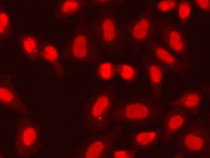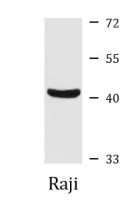ARG57335
anti-APTX antibody
anti-APTX antibody for ICC/IF,Immunoprecipitation,Western blot and Human
Overview
| Product Description | Rabbit Polyclonal antibody recognizes APTX |
|---|---|
| Tested Reactivity | Hu |
| Tested Application | ICC/IF, IP, WB |
| Host | Rabbit |
| Clonality | Polyclonal |
| Isotype | IgG |
| Target Name | APTX |
| Antigen Species | Human |
| Immunogen | Recombinant Protein of Human APTX. |
| Conjugation | Un-conjugated |
| Alternate Names | FHA-HIT; EAOH; AXA1; AOA; Forkhead-associated domain histidine triad-like protein; Aprataxin; AOA1; EC 3.-.-.-; EOAHA |
Application Instructions
| Application Suggestion |
|
||||||||
|---|---|---|---|---|---|---|---|---|---|
| Application Note | * The dilutions indicate recommended starting dilutions and the optimal dilutions or concentrations should be determined by the scientist. | ||||||||
| Positive Control | Raji |
Properties
| Form | Liquid |
|---|---|
| Purification | Affinity purification with immunogen. |
| Buffer | PBS (pH 7.3), 0.02% Sodium azide and 50% Glycerol. |
| Preservative | 0.02% Sodium azide |
| Stabilizer | 50% Glycerol |
| Storage Instruction | For continuous use, store undiluted antibody at 2-8°C for up to a week. For long-term storage, aliquot and store at -20°C. Storage in frost free freezers is not recommended. Avoid repeated freeze/thaw cycles. Suggest spin the vial prior to opening. The antibody solution should be gently mixed before use. |
| Note | For laboratory research only, not for drug, diagnostic or other use. |
Bioinformation
| Database Links | |
|---|---|
| Gene Symbol | APTX |
| Gene Full Name | aprataxin |
| Background | This gene encodes a member of the histidine triad (HIT) superfamily. The encoded protein may play a role in single-stranded DNA repair through its nucleotide-binding activity and its diadenosine polyphosphate hydrolase activity. Mutations in this gene have been associated with ataxia-ocular apraxia. Alternatively spliced transcript variants have been identified for this gene.[provided by RefSeq, Aug 2010] |
| Function | DNA-binding protein involved in single-strand DNA break repair, double-strand DNA break repair and base excision repair. Resolves abortive DNA ligation intermediates formed either at base excision sites, or when DNA ligases attempt to repair non-ligatable breaks induced by reactive oxygen species. Catalyzes the release of adenylate groups covalently linked to 5'-phosphate termini, resulting in the production of 5'-phosphate termini that can be efficiently rejoined. Also able to hydrolyze adenosine 5'-monophosphoramidate (AMP-NH(2)) and diadenosine tetraphosphate (AppppA), but with lower catalytic activity. [UniProt] |
| Calculated MW | 41 kDa |
Images (4) Click the Picture to Zoom In
-
ARG57335 anti-APTX antibody ICC/IF image
Immunofluorescence: A549 cells stained with ARG57335 anti-APTX antibody.
-
ARG57335 anti-APTX antibody WB image
Western blot: Raji cell lysate stained with ARG57335 anti-APTX antibody.
-
ARG57335 anti-APTX antibody IP image
Immunoprecipitation: 150 µg extracts of A549 cells were immunoprecipitated and stained with ARG57335 anti-APTX antibody at 1:500 dilution.
-
ARG57335 anti-APTX antibody IP image
Immunoprecipitation: 150 µg extracts of A549 cells using 3 µg ARG57335 anti-APTX antibody. Western blot was performed from the immunoprecipitate using ARG57335 anti-APTX antibody at 1:500 dilution.









